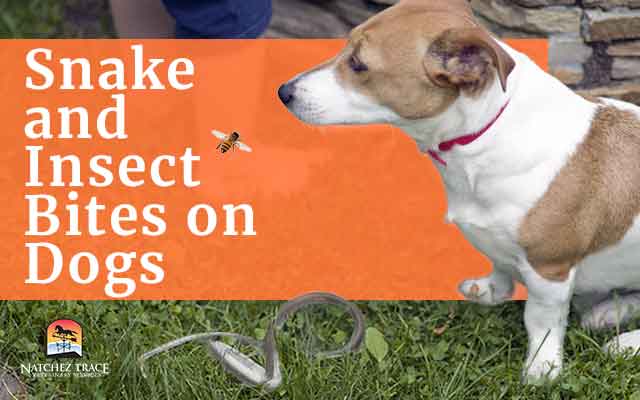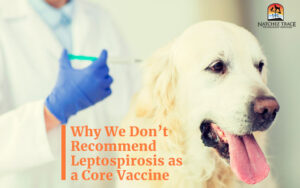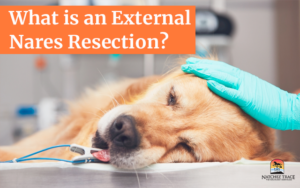Man’s faithful four-legged friends are not immune to the hazards lurking in their natural environment, including the perils of venomous encounters and the aftermath of insect bites.
From the stealthy strikes of venomous serpents to the painful repercussions of an insect’s sting, our dogs face diverse dangers outdoors. Understanding the repercussions of these encounters is crucial in safeguarding our canine companions.
The effects of these bites can range from mild discomfort to severe, life-threatening situations, necessitating prompt attention and informed action from pet owners. And these cases actually happen, especially in certain regions of the earth.
Watch how Dr. Smith treats a brown recluse spider bite on a dog below:
Know the intricacies of snake bites, insect stings, and their impact on dogs: the symptoms that manifest, the immediate care required, and the pivotal role of veterinary intervention in ensuring our furry friends’ swift recovery.
Through this understanding, we equip ourselves with the knowledge necessary to protect and support our canine companions in times of peril.
1. Snake Bites in Dogs: Understanding Venomous Encounters
Venomous snake bites present a significant threat to dogs. Understanding the effects of venom on a dog’s body is crucial in recognizing these potentially life-threatening situations promptly.
Venomous Snakes and Their Effects
- I
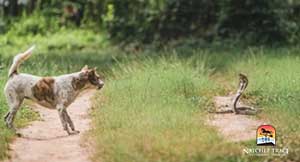 dentification: Rattlesnakes are known for their rattling tails and venom causing tissue damage and systemic effects. Copperheads have distinctive copper-colored heads and hourglass patterns, and their venom results in localized pain and swelling. Cottonmouths, prevalent in the southeastern US, possess venom with hemotoxic properties causing tissue damage, while coral snakes, identified by brightly colored bands, have neurotoxic venom affecting the nervous system.
dentification: Rattlesnakes are known for their rattling tails and venom causing tissue damage and systemic effects. Copperheads have distinctive copper-colored heads and hourglass patterns, and their venom results in localized pain and swelling. Cottonmouths, prevalent in the southeastern US, possess venom with hemotoxic properties causing tissue damage, while coral snakes, identified by brightly colored bands, have neurotoxic venom affecting the nervous system. - Venom Composition: Snake venom’s enzymes and toxins, such as phospholipases and neurotoxins, lead to tissue breakdown, inflammation, and potential paralysis in dogs. Hemotoxins disrupt blood clotting, causing hemorrhage and tissue damage, while venom proteins can trigger severe allergic reactions or anaphylaxis, leading to swelling, breathing difficulties, or shock. Rapid veterinary care is crucial to counter these effects and administer appropriate treatments after a snake bite to prevent severe complications.
- Impact on Dogs: Venom from snake bites in dogs leads to swift tissue breakdown, causing localized cell death, intense pain, and rapid swelling. Some venoms can induce systemic reactions, disrupting blood clotting, affecting nerves, and potentially triggering severe allergic responses. Swift veterinary care is crucial to manage these effects, administer treatments, and mitigate potential complications after a snake bite.
Symptoms of a Snake Bite
- Physical Manifestations: After a snakebite, dogs commonly exhibit localized swelling around the bite area, often accompanied by bruising and visible puncture wounds from the fangs. Tissue necrosis, characterized by blackened or dying skin, might develop in severe cases as the venom continues its damaging effects. Recognizing these symptoms promptly is crucial for seeking immediate veterinary care and managing the aftermath of the bite.
- Systemic Effects: Following a snakebite, dogs may experience systemic effects such as weakness, vomiting, labored breathing, and alterations in behavior. These signs can signal the venom’s systemic impact on the body, potentially indicating severe complications requiring urgent veterinary attention. Recognizing these systemic signs promptly is crucial for timely intervention and appropriate treatment post-snakebite.
Immediate Care and First Aid
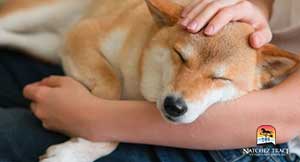 Pre-Veterinary Care: You should prioritize keeping your dog calm and limiting its movement to slow venom circulation. Gently cleaning the wound without manipulating or applying pressure helps reduce further venom spread. These initial steps aim to minimize the venom’s movement and prepare for immediate veterinary care, crucial for your dog’s recovery post-snakebite.
Pre-Veterinary Care: You should prioritize keeping your dog calm and limiting its movement to slow venom circulation. Gently cleaning the wound without manipulating or applying pressure helps reduce further venom spread. These initial steps aim to minimize the venom’s movement and prepare for immediate veterinary care, crucial for your dog’s recovery post-snakebite.- Avoid Home Remedies: It’s crucial to avoid attempting unverified home remedies or interventions post-snakebite. Instead, prioritize seeking immediate veterinary care without delay. Professional veterinary attention is essential for accurate assessment, appropriate treatment, and preventing potential complications after a snakebite.
Veterinary Treatment
- Antivenom Administration: Antivenom plays a crucial role in neutralizing snake venom by containing antibodies that counteract the venom’s effects. In veterinary settings, antivenom is administered based on the snake species and severity of the bite, helping mitigate the venom’s impact on the dog’s body. Timely administration of antivenom aids in reducing tissue damage, and systemic effects, and improving the dog’s chances of recovery post-snakebite.
- Supportive Care: Veterinarians offer comprehensive supportive care post-snakebite, including pain management to alleviate discomfort and wound care to prevent infection and aid healing. Additionally, they may administer supportive therapies like fluids to stabilize the dog’s condition and aid recovery. These treatments aim to manage the venom’s effects, minimize complications, and promote the dog’s overall recovery post-snakebite.
Recovery and Follow-Up
- Post-Treatment Care: Post-treatment care after a snakebite is crucial for a dog’s recovery, involving vigilant monitoring for potential complications. This care includes observing for signs of infection, swelling, or changes in behavior and ensuring follow-up visits as advised by Dr. Smith. Attentive post-treatment care aids in detecting and managing any lingering effects of the bite, supporting your dog’s complete recovery.
- Long-Term Impact: Snake bites can have lasting effects on a dog’s health and mobility, potentially leading to chronic pain, tissue damage, or impaired mobility in severe cases. Long-term complications might include scar tissue formation, persistent discomfort, or limitations in movement due to damaged nerves or tissues. Timely veterinary care and ongoing monitoring are vital to manage and minimize potential long-term impacts on the dog’s health post-snakebite.
2. Insect Bites and Stings in Dogs: Understanding Reactions and Remedies
Insects like bees, wasps, spiders, and ticks can inflict painful bites or stings on dogs, triggering varied reactions. Understanding these encounters and their effects on dogs is crucial in providing timely care and alleviating discomfort.
Common Insects and Their Bites
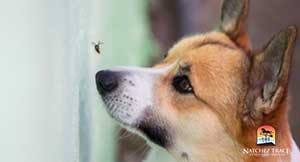 Identifying Culprits: Common insects that bite or sting dogs include bees, wasps, spiders, and ticks. These insects can cause various reactions ranging from localized irritation to severe allergic responses in dogs.
Identifying Culprits: Common insects that bite or sting dogs include bees, wasps, spiders, and ticks. These insects can cause various reactions ranging from localized irritation to severe allergic responses in dogs.- Venom and Irritants: Insect venom and irritants contain proteins and toxins that can trigger allergic reactions or localized responses in dogs. These components can cause symptoms ranging from mild irritation, swelling, and pain to severe allergic reactions or systemic effects in sensitive dogs post-insect bites or stings.
Reactions and Symptoms
 Localized reactions: Localized reactions to insect bites or stings in dogs typically manifest as redness, swelling, and pain at the bite site. These symptoms usually appear near the area of the sting or bite and may vary in intensity depending on the dog’s sensitivity to the insect’s venom or irritants.
Localized reactions: Localized reactions to insect bites or stings in dogs typically manifest as redness, swelling, and pain at the bite site. These symptoms usually appear near the area of the sting or bite and may vary in intensity depending on the dog’s sensitivity to the insect’s venom or irritants.- Systemic reactions: Systemic reactions in dogs post-insect bites or stings can range from mild allergic responses to severe anaphylaxis. Symptoms may include generalized itching, hives, difficulty breathing, swelling of the face or throat, vomiting, diarrhea, weakness, collapse, or shock in severe cases.
Immediate Care and First Aid
- Immediate steps: You should promptly remove stingers (if present), clean the affected area with mild soap and water, and apply cold compresses to reduce swelling post-insect bites or stings in dogs. These immediate actions aim to minimize discomfort and prepare for further veterinary care if necessary.
- Avoiding self-treatment: Avoid attempting unverified home remedies post-insect bites or stings in dogs and prioritize seeking veterinary advice for proper care. Professional guidance ensures appropriate treatment and reduces the risk of complications associated with self-treatment.
Veterinary Treatment
- Treatment approaches: Veterinary treatments for insect bites in dogs often involve antihistamines or corticosteroids to manage allergic reactions and reduce inflammation. Additionally, supportive care such as pain management or antibiotics might be administered based on the severity of the reaction to alleviate discomfort and
 prevent secondary infections.
prevent secondary infections. - Allergic reactions: In cases of severe allergic reactions or anaphylaxis post-insect bites in dogs, immediate veterinary intervention is crucial. Dr. Smith may administer emergency medications like epinephrine, intravenous fluids, or oxygen therapy to manage severe symptoms and stabilize your dog’s condition swiftly.
Preventive Measures and Considerations
- Environmental management: Minimizing insect exposure in your dog’s environment involves measures like keeping grass and foliage trimmed, using pet-safe insect repellents, and regularly checking for and removing potential insect breeding sites. These actions reduce the likelihood of insect encounters, decreasing the risk of bites or stings for dogs.
- Vaccinations and preventive care: Preventative care for insect-related conditions in dogs includes vaccines for specific diseases transmitted by insects and the use of preventive treatments such as tick preventatives to minimize the risk of infections. These measures significantly contribute to protecting dogs from insect-borne diseases and reducing potential health threats.
Long-Term Monitoring and Follow-Up
- Observation and care: After insect bites or stings, closely observe the dog for prolonged or recurring symptoms, as these may indicate ongoing issues or secondary infections. Seeking follow-up veterinary care if symptoms persist or worsen is crucial for ensuring the dog’s continued well-being post-insect encounter.
- Precautions for future encounters: To reduce the risk of future insect bites or stings, you should avoid areas with high insect activity, especially during peak seasons. Additionally, using insect repellents and protective clothing, such as dog-safe insect repellents or protective gear, can further minimize the chances of insect encounters.
3. Immediate Care for Dog Bites: Swift Actions in Critical Moments
When your dog encounters venomous creatures or experiences severe insect stings, swift action becomes paramount. Implementing immediate care techniques is crucial to minimize the impact of these dangerous bites on your pet’s well-being.
Snake Bites
- Assessment: Prioritize safety for both yourself and your dog. Attempt to identify the snake if possible, but don’t attempt to capture or handle the snake.
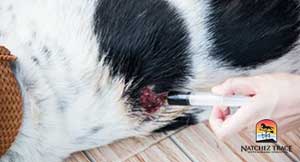 Restriction of Movement: Aim to keep your dog calm and restrict movement to slow the spread of venom; gently transport or carry your dog, minimizing activity to prevent further venom circulation.
Restriction of Movement: Aim to keep your dog calm and restrict movement to slow the spread of venom; gently transport or carry your dog, minimizing activity to prevent further venom circulation.- Wound Management: Avoid tourniquets, ice, or attempts to suck out venom; focus on gently cleaning the wound with mild soap and water, if feasible, without applying undue pressure.
Severe Insect Stings
- Stinger Removal: If stingers are visible, remove them carefully using tweezers or a scraping motion. Avoid squeezing the venom sac, which could release more toxins.
- Immediate Cooling: Apply a cool, damp cloth or cold compress to reduce swelling and soothe the affected area.
- Monitoring for Allergic Reactions: Observe your dog closely for signs of severe allergic reactions such as swelling of the face, difficulty breathing, or collapse.
First Aid Before Veterinary Attention
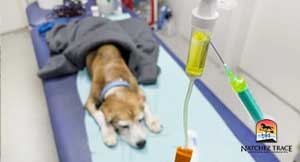 Contact Us: Immediately seek professional veterinary help. Notify our office in advance so we can prepare for your arrival.
Contact Us: Immediately seek professional veterinary help. Notify our office in advance so we can prepare for your arrival.- Avoid Home Remedies: Refrain from applying unverified home remedies, medications, or interventions without our guidance.
Transportation and Precautions
- Safe Transport: If possible, carry or transport your dog gently and securely to our clinic.
- Minimize Stress: Keep your dog calm and warm during transportation. Avoid unnecessary handling or excessive movement.
Emergency Veterinary Care
- Inform Dr. Smith: Upon arrival, inform us about the suspected snake bite or insect sting and the immediate care measures taken.
- Veterinary Intervention: Allow us to perform comprehensive assessments and administer appropriate treatments, including antivenom or allergy management.
4. Veterinary Treatment
We employ a range of treatments tailored to the specific nature and severity of the bite or sting, aiming to alleviate symptoms, neutralize venom effects, and support the dog’s recovery process. Seeking professional veterinary care remains paramount in ensuring the best possible outcome for affected dogs.
Snake Bites
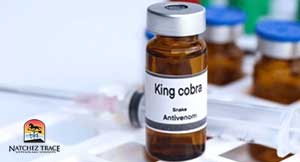 Antivenom Administration: We may administer antivenom specific to the snake species, neutralizing venom effects.
Antivenom Administration: We may administer antivenom specific to the snake species, neutralizing venom effects.- Pain Management: Provide pain relief through medications to alleviate discomfort and swelling.
- Supportive Care: Offer supportive measures such as fluids and wound management to aid the dog’s recovery.
Severe Insect Stings
- Medications: We may prescribe antihistamines or corticosteroids to manage allergic reactions.
- Wound Care: Treat affected areas to prevent infection and promote healing.
- Monitoring: Monitor for anaphylactic shock or severe systemic reactions requiring immediate attention.
Allergic Reactions
- Anaphylaxis Management: Address severe allergic reactions promptly with epinephrine or other emergency medications.
- Observation: Keep your dog under observation to ensure stability and monitor for further complications.
Systemic Support
- Assessment and Monitoring: Evaluate your dog’s overall condition and provide ongoing monitoring for potential complications.
- Long-term Recovery: Offer guidance for post-treatment care and rehabilitation as needed for optimal recovery.
5. Preventive Measures
The preventive measures explained below aim to minimize the risk of venomous encounters and insect bites, promoting a safer environment for dogs.
Snake Bite Prevention
 Environmental Awareness: Educate yourself about snake habitats and cautionary measures in these areas.
Environmental Awareness: Educate yourself about snake habitats and cautionary measures in these areas.- Leash Control: Promote leash use in high-risk areas and while hiking to maintain proximity and control over dogs.
- Training: Teach dogs to “leave it” and recall commands to prevent interactions with snakes.
Insect Bite Avoidance
- Environmental Management: Keep outdoor areas clear of potential insect habitats, such as standing water or nests.
- Protective Gear: Consider using insect repellents or protective gear, like insect-repellent collars or clothing for dogs.
- Regular Check-ups: Schedule regular veterinary check-ups to monitor and prevent parasite infestations.
Vaccinations and Preventive Treatments
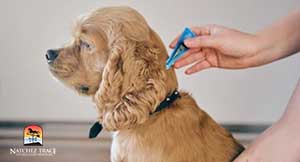 Vaccines: Discuss vaccination options against specific insect-borne diseases with Dr. Smith (e.g., Lyme disease).
Vaccines: Discuss vaccination options against specific insect-borne diseases with Dr. Smith (e.g., Lyme disease).- Parasite Control: Implement preventive measures against ticks, fleas, and other parasites that can transmit diseases.
Education and Awareness
- Pet Owner Education: Educate yourself on venomous species in your region, symptoms of bites, and preventive actions.
- Emergency Preparedness: Have a basic understanding of emergency first aid for bites or stings.
Behavioral Modifications
- Avoidance Training: Train your dog to avoid areas where snakes may hide or to steer clear of insects in the environment.
- Supervision: Supervise your pet closely during outdoor activities to prevent encounters with venomous creatures.
6. Safeguarding Dogs from Venomous Encounters and Insect Bites
Protecting your canine companion from the perils of snake bites and insect stings is paramount for responsible pet ownership. Understanding the potential dangers and implementing preventive measures can significantly mitigate the risks associated with venomous encounters.
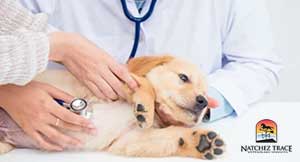 By staying vigilant in venomous species-prone areas and prioritizing training, vaccinations, and regular veterinary check-ups, you can create a safer environment for your dog. Training dogs to avoid potential dangers and educating yourself about emergency first aid measures also play a pivotal role in canine safety.
By staying vigilant in venomous species-prone areas and prioritizing training, vaccinations, and regular veterinary check-ups, you can create a safer environment for your dog. Training dogs to avoid potential dangers and educating yourself about emergency first aid measures also play a pivotal role in canine safety.
Remember, immediate care and seeking professional veterinary attention remain crucial if a venomous encounter occurs. Early intervention can significantly impact your dog’s recovery and reduce the severity of the effects caused by snake bites or insect stings.
To ensure our furry companions enjoy a safe and joyful life, it’s essential to remain proactive in preventing snake and insect encounters, ultimately safeguarding dogs from potential harm.
Stay vigilant, stay informed, and prioritize preventive measures to keep your dog safe from venomous encounters and insect bites.
If you think your pet was bitten by a venomous insect or snake, contact us right away.
People Also Ask
How can I tell if my dog has been bitten by a snake or stung by an insect?
Look for symptoms like sudden swelling, pain, or visible bite marks around the affected area.
Signs of distress, such as excessive drooling, difficulty breathing, or weakness, might indicate a severe reaction.
What should I do if my dog is bitten by a snake or stung by an insect?
Seek veterinary attention immediately, even if the symptoms appear mild.
Minimize movement and keep the dog calm to slow down venom circulation or allergic reactions.
How can I prevent my dog from encountering venomous creatures or insects?
Keep dogs on leashes during walks in areas known for snakes or high insect activity.
Educate yourself about the venomous species in your region and take preventive measures, such as using insect repellents or keeping a well-maintained yard.

